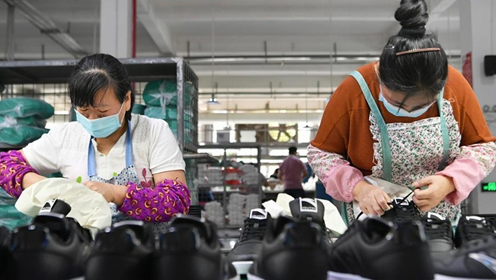
Workers make shoes at a shoemaking company in Putian, southeast China's Fujian Province, April 27, 2020. Under strict measures taken to fight against the COVID-19, some manufacturing enterprises in Putian have made efforts to ensure stable performance in employment and production. (Photo: Xinhua)
Employment has become the uppermost priority at this year's two sessions -- even more than setting a GDP growth target -- underscoring the rising pressure on China's job market, but deputies and political representatives are proposing policies that will ensure stability in the labor market.
In his suggestion, Wu Yunbo, a National People's Congress deputy from North China's Inner Mongolia Autonomous Region, called for the government to help young people who grew up in villages find employment back home, which would also support the development and revitalization of rural areas.
"There is a talent shortfall in rural pastoral areas, but only talent can bring development and prosperity to villages," he told the Global Times on Wednesday.
"Townships and villages can absorb many working-age people. China has more than 700,000 villages and if each village can take in 10 workers, that is a lot of job creation," Wu said. Each village "can provide many positions, such as technical personnel with knowledge of soil improvement, farming, livestock husbandry management, finance and medicine."
He suggested the country sign agreements with the young people and offer administrative rewards based on the concrete changes they bring to villages.
Fu Jun, chairman of Macrolink Group who is also a member of the Chinese People's Political Consultative Conference national committee, suggested that the government should increase investment in the new infrastructure sector to create jobs, and upgrade the existing job market structure.
Strengthening new infrastructure development could empower traditional industries and realize innovative transformation, he told the China Economic Weekly.
"Supported by technologies such as big data, cloud computing and artificial intelligence, new infrastructure can create new demand, promote the upgrading of consumption, and promote the development of new forms of business."
China's job sector is facing huge pressure brought about by the COVID-19 and an economic growth slowdown that began in 2018. This combination has drawn some doubt in the Western media about whether China could reach its employment target.
Indeed, the pressure is intense as the surveyed unemployment rate hit 6.2 percent in February - the highest in at least a decade. About 50 million migrant workers were kept at home due to pandemic prevention measures. In addition, there will be 8.74 million new graduates in the coming weeks.
"From consumption to investment and exports, the three major components of GDP in China have been simultaneously affected by the pandemic, resulting in severe job losses and unprecedented pressure," Tian Yun, vice director of the Beijing Economic Operation Association, told the Global Times on Wednesday.
In the Government Work Report on Friday, Chinese Premier Li Keqiang said that "this year, we must give priority to stabilizing employment and ensuring living standards…We will strengthen the employment-first policy with comprehensive measures."
These measures include a 2.5 trillion ($350 billion) tax cut, a 1 trillion yuan government spending, and 1 trillion yuan worth of government bonds, as well as prudent monetary policy that's conducted in a more flexible and appropriate way, and other financing support such as preferential loans.
To ensure employment and public wellbeing, "we must instill confidence in over 100 million market entities; and we must do our utmost to help enterprises, particularly micro-sized, small and medium-sized businesses, and self-employed individuals, to get through this challenging time," read the report.
"For hedging the pressure on employment, the measures and intensity introduced by the central government are also unseen before," Tian noted, adding that "all of these measures, if well implemented, will make sure the job market will go back to positive growth, as long as the pandemic situation is under control."
"For example, the 2 trillion yuan mentioned above will be transferred in full to local governments, and the funds will go directly to prefecture and county governments and directly benefit businesses and people; this the first time the central government is doing so."
In addition, China has room to increase the fiscal deficit ratio, which was set to be at least 3.6 percent, Tian said.
"In some Western countries, deficit ratios are much higher than in China, with ratios in the US and Japan as high as 10 percent. Thus, China has the policy flexibility to address the employment issue."
"China has the largest employment in the manufacturing sector, with small and medium-sized businesses holding a majority, so as long as the manufacturing sector is stable, employment will be also stable," Zhou Dewen, deputy director of the China Association of Small and Medium Enterprises, told the Global Times.
Facing the unprecedented pandemic, many Western media outlets have voiced doubt about whether China will be able to achieve its development goals.
"The COVID-19 pandemic has truly slowed down the world's economic growth and interrupted many countries' economic plans such as China, the US and many European countries. But it is noticeable that, amid COVID-19, China is the only country so far, to have quickly resumed business operations while improving the pandemic situation," Tian noted.


